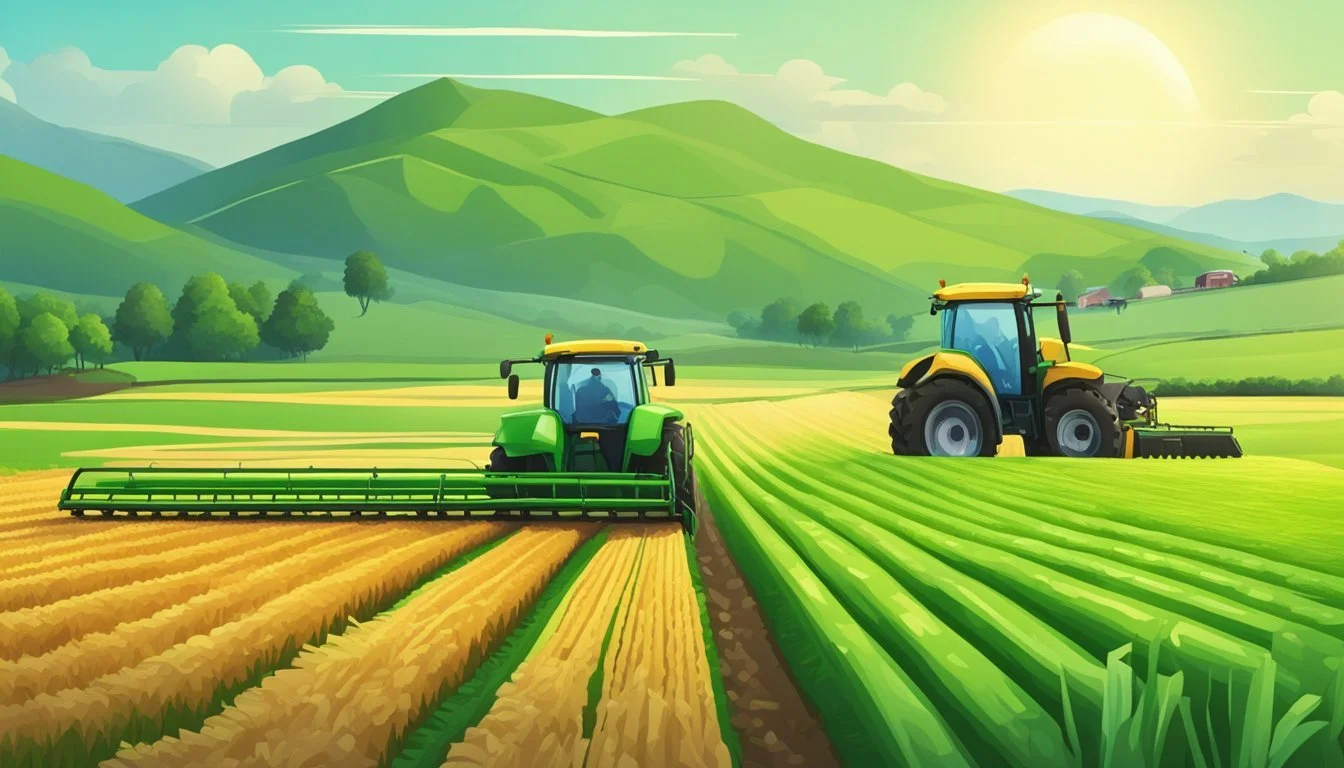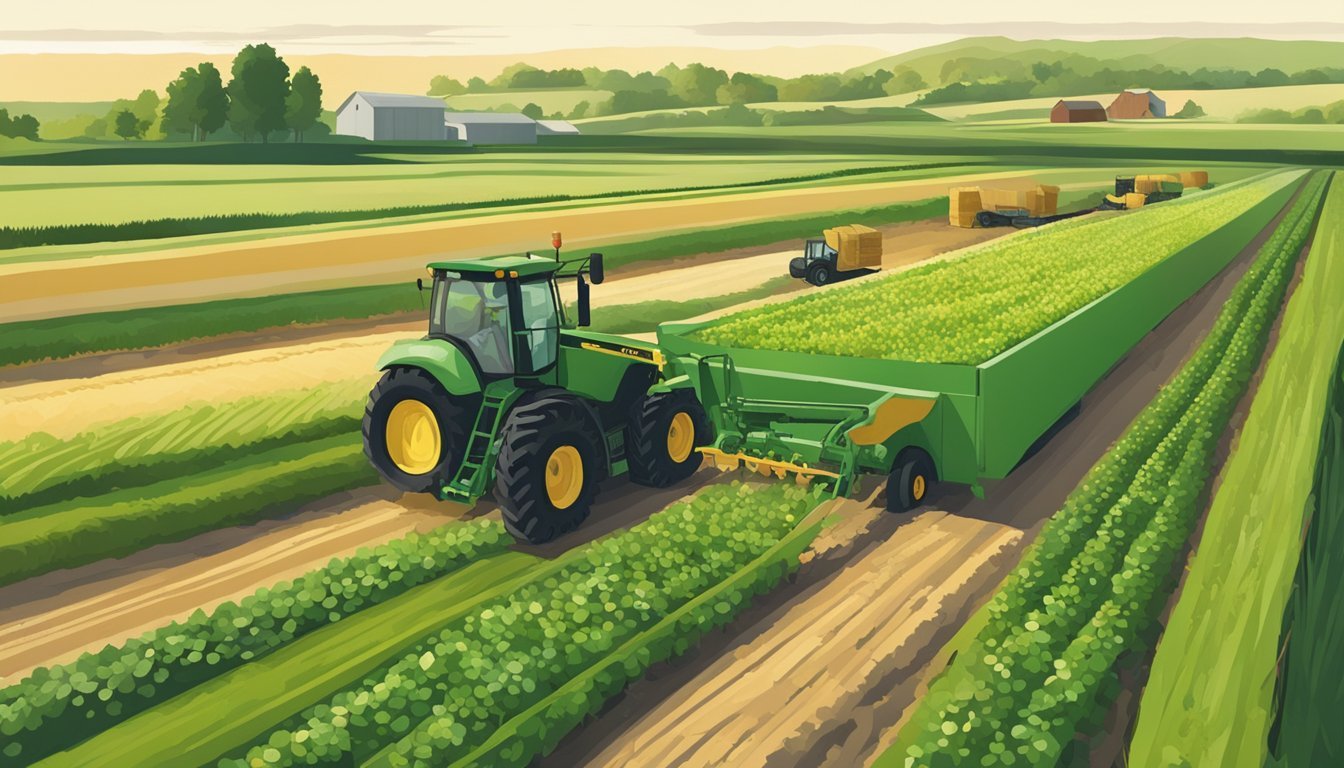Guide to Farming in Wisconsin
Essential Tips for Successful Agriculture
This Article is Part of Our State by State Farming Guide
Wisconsin, long recognized for its dairy industry, offers fertile grounds for a variety of agricultural ventures. Agriculture plays a pivotal role in the state's economy, and aspiring farmers find Wisconsin to be a promising location to establish their operations. Its rich soil and diverse climate allow for the cultivation of numerous crops and the raising of various livestock. The state provides resources and support for beginning farmers, ensuring they have access to information necessary to create successful farm businesses.
Those interested in starting their farm in Wisconsin must consider several factors to ensure sustainable and profitable outcomes. Comprehensive education on the chosen farming enterprise is crucial, alongside developing a clear farm business plan that includes a unique value proposition for potential customers. The state's agritourism is burgeoning, and farmers can leverage this by adding value to their standard farming models.
Wisconsin's Department of Agriculture, Trade and Consumer Protection (DATCP), alongside other agencies like the USDA Farm Service Agency and UW-Madison Extension, offers guides and resources that connect farmers with relevant information. These resources include risk management strategies and soil management practices, which are key for maintaining productive farms. Therefore, stepping into Wisconsin's agricultural landscape comes with the promise of support and a community keen on innovation and growth.
Getting Started in Wisconsin Farming
Wisconsin's rich agricultural heritage and resources make it an inviting place for new farmers to lay down roots. Prospective farmers should begin with a solid plan, addressing the specific vision they have for their farm. Identifying the type of agricultural enterprise and developing a clear value proposition for potential customers is crucial.
The state provides a plethora of resources to assist in planning, forming, and operating a farm. Farmers can access these resources through various means:
USDA Service Centers: A first point of contact for new farmers, providing information on federal programs and services.
Online Platforms: Websites and databases offer guidance on best practices and networking opportunities.
Learning Opportunities:
Training and Education Programs
Ag Apprenticeships
On-Farm Training
In Wisconsin, organizations offer training programs that include production, business planning, and farm financials guidance. Furthermore, innovative apprenticeships and on-farm experiences equip farmers with practical knowledge.
Key Steps for Beginning Farmers:
Research: Understand the local agricultural landscape.
Educate: Engage in training and educational programs.
Plan: Craft a detailed business plan.
Connect: Utilize state and online resources for assistance.
Implement: Form and operate the farm using acquired knowledge.
It’s essential for new farmers to consult with experienced agricultural professionals in Wisconsin, contributing to informed decision-making and the successful establishment of their farms.
Understanding Wisconsin's Agriculture Landscape
Wisconsin's agriculture is diverse, reflecting variations in regional practices and climate conditions that influence the growing season. The state's farmers are known for their resourcefulness in adapting to these elements to enhance productivity and sustainability of their farming operations.
Regional Farming Practices
Different regions within Wisconsin specialize in various forms of agriculture due to the state's varied topography and microclimates. In the northern and central areas, dairy farming is prolific, making Wisconsin renowned as “America's Dairyland”. The dairy industry is one of the state's largest sectors, with dairy products contributing significantly to the state economy.
Moving to the southern and western regions, crop farming becomes more predominant. Here, farmers primarily grow corn, soybeans, and oats. These crops comprise a vital part of the state's agricultural output, with an emphasis on sustainable practices to ensure long-term soil fertility and productivity.
Climate and Growing Season
Wisconsin's climate has a substantial impact on its agricultural output, with a growing season that generally runs from late May to early October. However, this can vary depending on the region. The state's farmers must be attentive to:
Planting times: Adjusting planting schedules to coincide with optimal soil temperatures and moisture levels.
Climate challenges: Preparing for and mitigating risks associated with frost, extreme weather events, and temperature fluctuations.
Farmers also utilize climate-smart agriculture techniques to address environmental concerns, including increasing continuous living ground cover to reduce soil erosion and nutrient runoff, thus protecting the integrity of Wisconsin's natural resources.
Economic Insights and Funding Opportunities
Wisconsin's farming sector is distinguished by diverse economic prospects and robust funding mechanisms. This section addresses the financial intricacies tied to agricultural operations and outlines the myriad of support and resources available.
Farm Economics
Wisconsin's agricultural landscape is characterized by a variety of economic activities that contribute to its viability. Farmers must consider the costs associated with their operations, which include but are not limited to land, equipment, seeds, and livestock. Economic sustainability revolves around not just managing these costs but also capitalizing on market opportunities to create profitable farm businesses.
Key Factors Affecting Farm Economics:
Land and equipment acquisition and maintenance costs
Prices of seeds, fertilizers, and other supplies
Labor costs and availability
Market demand and pricing for farm products
Funding and Resources
The array of funding and assistance programs in Wisconsin underscores the state's commitment to fostering agricultural success. Key entities such as the Wisconsin Department of Agriculture, Trade and Consumer Protection (DATCP) and the United States Department of Agriculture (USDA) offer various grants and funding opportunities. Encouragingly, options range from Buy Local, Buy Wisconsin Grants that support local food initiatives to Meat and Poultry Supply Chain Resiliency Grants bolstering infrastructure.
Selected Funding Opportunities in Wisconsin:
Buy Local, Buy Wisconsin Grants: Enhance marketing opportunities for local food producers.
Dairy Processor Grants: Improve dairy processing facilities and foster innovation.
Farm to School Grant: Connect schools with local agricultural producers.
Wisconsin Local Food Purchase Assistance Program: Support local farmers by promoting purchase of their produce for food assistance programs.
Meat Processor Infrastructure Grant: Upgrade meat processing facilities and capacity.
In addition to the above, the USDA further invests in rural expansion and market exposure for farmers, reinforcing economic growth. The Farm Service Agency (FSA) also plays a pivotal role in delivering farm assistance programs.
Sustainable Farming and Water Quality
Sustainable farming in Wisconsin directly influences water quality. Farmers across the state are adopting practices that contribute to clean waterways while ensuring agricultural productivity. Organic agriculture, specifically, is one example where sustainable methods are employed to benefit the environment.
Organic farms adhere to strict guidelines that prohibit the use of synthetic pesticides and fertilizers, reducing the risk of water contamination. Instead, they employ natural methods for pest control and soil fertility. The use of cover cropping and minimal tillage practices are common on organic farms, helping to prevent soil erosion and reduce runoff into water bodies.
In Wisconsin, programs like the Clear Water Farms Program highlight success stories where farms have implemented sustainable practices with positive outcomes for water quality. Cover crops, for example, play a pivotal role:
Cover Crop Benefits - Enhance soil structure - Improve infiltration - Reduce nutrient runoff
The Agriculture Water Quality initiative by the University of Wisconsin-Madison Division of Extension provides educational resources emphasizing the link between agricultural practices and water outcomes. Farmers are encouraged to use tools such as the Field Walkover Guide to assess their farms' conservation needs.
These efforts underscore that sustainable farming practices are not only beneficial to the environment but are also vital for the longevity of the farming industry in Wisconsin. Through education and continued adaptation of sustainable methods, farmers are contributing to a legacy of cleaner water for all.
Agriculture Technology and Services
Wisconsin's agricultural landscape leverages cutting-edge technology and a range of services to enhance farming productivity and sustainability. The state's farmers and service providers continually adopt innovative practices to remain competitive and environmentally responsible.
Innovations in Farming
Wisconsin farmers are employing advanced technologies, such as moisture sensors, drones, and smart irrigation systems, to increase the efficiency of their operations. GPS-enabled tractors and terrain contour mapping tools are notable examples that contribute to precise farming practices, reducing waste and optimizing resource usage.
Moisture sensors help in the accurate monitoring of soil moisture levels, assisting farmers with informed irrigation decisions.
Drones provide aerial data for crop monitoring, health assessment, and even planting or spraying.
Smart irrigation systems conserve water by deploying it when and where it’s most needed.
Utilization of terrain contour mapping aids in the understanding of field topography, which can influence crop yields and guide water management strategies.
Custom Farming Services
Custom farming services are a significant component of Wisconsin’s agricultural industry. They offer tailored solutions ranging from tillage to harvest, benefiting farmers who might not have the necessary equipment or expertise.
Custom operators provide services based on the latest custom rate guide, which reflects current pricing norms and practices.
A survey of rates and services helps farmers in making informed decisions about the collaboration with custom operators.
These services often include tillage, planting, pest control, harvesting, and more.
Service Offered Purpose Tillage Soil preparation for optimizing planting conditions Planting Custom seeding rates and precision placement Pest Control Tailored pesticide application for crop health Harvesting Timely and efficient crop gathering using specialized equipment
Custom farming services enable producers to access a wide skill set and modern equipment, leading to more efficient and ecologically conscious practices, which are crucial in today's market.
Crop Management and Harvesting Techniques
Successful crop management in Wisconsin requires a systematic approach, starting with a well-structured crop plan. Farmers should decide on planting schedules, transplanting timings, and harvesting intervals based on the specific crops they are growing. These decisions are critical as they directly impact weekly yields throughout the growing season.
Effective Crop Maintenance:
Regular monitoring for pests and diseases is paramount, employing integrated pest management strategies when needed.
Employ nutrient management plans to ensure crops receive the right balance of fertilization, promoting healthy growth and maximizing yields.
Harvesting Consideration:
Achieve quality and longevity of produce by minimizing mechanical injury during harvesting.
Implement prompt cooling after harvest to maintain freshness.
Optimal Storage Conditions:
Maintain the crop’s optimum storage temperature to prevent spoilage.
Manage humidity levels to minimize water loss.
Harvesting Practice Objective Gentle Handling Reduce bruising and damage Swift Cooling Retain freshness and extend shelf-life Temperature Control Preserve quality and prevent decay Humidity Management Avoid dehydration and weight loss
Farmers should adapt these guidelines to their specific crop types and local environmental conditions in Wisconsin, tailoring their approach to each season's unique challenges. With thoughtful management and effective harvesting techniques, farmers can achieve sustainable productivity and quality in their produce.
Horticulture and Organic Farming
Wisconsin's prominence in organic farming is a testament to its commitment to sustainable and ecologically responsible agricultural practices. The state is recognized for its vast number of organic farms and extensive organic acres, which cater to both local and broader markets through various channels, such as farmers markets.
Organic Crop Production
In Wisconsin, organic farmers are dedicated to fostering healthy soil and ecosystems without reliance on synthetic fertilizers, sewage sludge, or genetically modified organisms (GMOs). They adhere to the National Organic Program (NOP) regulations, incorporating an organic system plan to strategically manage crop rotations, natural pest controls, and organic-compliant soil amendments.
Key Practices in Organic Crop Production:
Soil Management: Utilizing compost, green manure, and organic mulch to maintain soil fertility.
Pest Control: Emphasizing biological pest control and employing organic-approved substances when necessary.
Seeds and Planting Material: Using organic seeds and plant materials, avoiding GMOs to preserve genetic diversity and integrity.
Marketing and Farmers Markets
Marketing for organic farmers in Wisconsin involves strategic positioning to reach consumers who prioritize organic produce. Farmers markets play a pivotal role in this strategy, facilitating direct sales from producers to consumers. At these markets, organic farmers can showcase the value of their crops and demonstrate their commitment to sustainable agriculture.
Farmers Market Benefits:
Direct Sales: Farmers sell directly to consumers, allowing for full price realization and immediate feedback.
Consumer Education: These venues provide opportunities for consumer engagement and education about the benefits of organic produce.
Community Building: Farmers markets foster a sense of community and connection between local producers and consumers.
Agricultural Education and Learning Resources
Wisconsin offers an array of agricultural educational opportunities and resources for individuals interested in farming. These resources cater to various levels of experience, from beginners to those expanding their agribusinesses.
Educational Programs and Workshops: Aspiring farmers in Wisconsin can participate in on-farm apprenticeships and mentorships. These hands-on programs provide practical knowledge in production, business planning, and farm management. Short-term workshops and longer curriculum-based programs are also available and often focus on farm financials and sustainable agricultural practices.
Resources from Local Institutions: Educational materials are distributed by entities such as Wisconsin Ag in the Classroom, making lesson plans, Ag Mags, and other readers accessible. These resources aim to enhance students' understanding of agriculture and prepare them for potential careers in the field.
Online Guides and Tools:
Wisconsin Beginning Farmer Resource Guide: A roadmap for new farmers detailing available state-wide resources.
AgrAbility of Wisconsin: A guide for farmers with disabilities, focusing on cultivating accessible and successful agricultural careers.
National Agricultural Statistics Service (NASS) and U.S. Department of Agriculture (USDA):
The NASS provides crucial farming data that supports planning and decision-making.
The USDA offers extensive resources through its Cooperative Extension System, including research, funding opportunities, and educational materials for farmers at all stages.
By employing these educational and learning resources, individuals interested in Wisconsin farming can gain the knowledge and skills required for successful agricultural ventures.










